Intakes, Fuel Trims, and AFR
#1
Intakes, Fuel Trims, and AFR
Those who have a wideband in their car will notice that at idle or cruising (closed loop) the AFR is at 14.7:1, i.e. the ECU is telling the injectors to spray 1 part of fuel for the 14.7 parts of air that are flowing through the MAF.
So why 14.7:1?
14.7:1 keeps the CAT happy, emissions low, and provides decent fuel economy. The best fuel economy comes at 15.2:1, but that will damage the CAT. Now that the target has been set, how is it achieved?
The front O2 sensor of your Evo has the important job of sending a signal to the ECU telling it if the AFR is in closed loop. Think of the front O2 sensor as a switch. When the AFR is at 14.7:1 the switch is turned off. When the AFR is either too rich (<14.7:1) or too lean (>14.7:1) the switch is turned on. When the switch is on you can have the following two conditions:
1. The AFR is too rich (<14.7:1). The ECU receives the signal from the front O2 sensor and then sends a signal to the injectors telling them to spray less fuel at idle or cruise to bring back the AFR to 14.7:1.
2. The AFR is too lean (>14.7:1). The ECU receives the signal from the front O2 sensor and then sends a signal to the injectors telling them to spray more fuel at idle or cruise to bring back the AFR to 14.7:1.
Luckily for us we can log these conditions with Evoscan or any other generic logger (PCMScan). These parameters are known as fuel trims. There are short term fuel trims (STFT) and long term fuel trims (LTFT). The STFTs change rapidly and feed into the STFT which on the Evo change every 4 minutes. There are three LTFTs, our main concern is with the LTFT-low (idle) and LTFT-mid (cruise).
On the Evo the LTFT ranges between +/-12.5%. What does that mean?
Let us say that your driving your stock Evo and logging the LTFT cruise. At a steady speed the LTFT cruise changes every 4 minutes. After two 4 minute cycles, the LTFT cruise is +5%. What does that mean? It means that the ECU was told by the front O2 sensor to add 5% fuel to bring back the AFR to 14.7:1 at cruise. Basically, the O2 sensor noted that the AFR has leaned over time and told the ECU to compensate to get the AFR back to 14.7:1.
You stop and fill gas from new gas station and then you drive some more at a steady speed. After 3-4 cycles you look at the LTFT and all of a sudden it is -3%. So the O2 sensor noticed that the new gas is causing a rich condition and told the ECU to tell the injectors to spray 3% less gas. Basically, the cruise AFR was richer than 14.7:1 and the ECU was tasked with bringing it back to 14.7:1.
The above process goes on and on and on. The ECU never stops adjusting the trims to achieve 14.7:1. This is done to keep the CAT happy, emissions down, and fuel economy decent.
The problem is that LTFT cruise carries over into WOT operation. Let us say that your LTFT is at +8%. The fuel map in the rom is telling the ECU to adjust AFR to 10:1 @ 4000 rpm. Let us assume that the target AFR is the actual AFR. I know it is not, but play along or assume it is a Subaru where the target AFR is very close to actual AFR. Your logging this AFR with a wideband and the log says that the actual AFR is 10.8:1 and not 10:1. Why is that? Here is the math: 10x0.08=0.8-10=9.2:1. The rich trim has made the actual AFR richer than it is in the map.
Conversely, let us say that the LTFT is -8% and the target AFR in the map is 10.5:1 @ 3500 rpm. The wideband reads 11.34:1 AFR. Let us do the math: 10.5x0.08=0.84+10.5=11.34:1. So now the negative LTFT at cruise has carried over to WOT and made your actual AFR leaner than the target AFR in the map.
As long as the LTFT do not swing widely, then the actual AFR does not swing widely from the actual AFR.
Then, you go an install an open filter intake. Now all bets are off. Your LTFT go nuts. Why? Your MAF is now seeing a totally different airflow through it and is telling the ECU to adjust the injectors accordingly. I have logged Evo Xs with intakes that have drifted the LTFT to +11.9%. YIKES!!! Basically, the O2 sensor was sensing a lean condition and signaling the ECU to have the injectors pump more fuel to combat that condition.
Let me give you a real life example: The chart below is from an Evo X that has an intake, tbe, uicp. The table on the left is the AFR and on the right is the LTFT. This is one 4th gear WOT log.

The AFR was set to peak at 12:1 and taper to 11.2:1 by redline when the fuel trims were at 10.2%, i.e. the ECU was adding 10.2% fuel to bring back the AFR to 14.7:1 in closed loop.
The chart below is on the SAME car after the trims fell to 6.3%. Basically, the ECU reduced the fuel addition by 3.9%, 10.2-6.3=3.9%.

Look what happened to the AFR as a consequence of the change in trims. It leaned out all across the rpm range. The fuel map was not changed on the car and the car was hitting pretty much the same load cells. Take the 5000 rpm 220 load cell, for example. It was at 11.5:1 when the trim was 10.2%, then the trim fell by 3.9%. Let us do the math: 11.5x0.039=0.45+11.5=11.95:1 AFR. Now look at the “new” AFR in load cell 220 @ 5000 rpm and it is 11.9:1. The 3.9% fall in LTFT leaned out the car from 11.5:1 to 11.9:1.
Let us take a more hypothetical example. You go to a shop and install a very popular intake, then the tuner proceeds to tune the car and the trims were +2%. He sets the AFR at 11:1. Gradually, your trims drift to 12%. You log your AFR and you find that your AFR is a rich 9.68:1. Let us do the math: 11x0.12=1.32-11=9.68. You think to yourself what the hell happened to my AFR? Well, the tuner failed to adjust the injectors/MAF to the new airflow from the intake.
Whenever an intake is installed on an Evo X, the fuel trims must be logged and if they have drifted beyond +/-5% (Cobb suggests +/-8%), then the injector latency or the MAF scaling MUST be adjusted to bring back the trims into line. Unfortunately, this takes a lot of time. Consider that the trims change every 4 minutes and you must log them until they settle, then change the latency and log them some more until they settle close to +/-5%. It takes at least an hour to do all this.
For the past three Evo Xs that I have tuned I have been doing this. Not all Evos with intakes require it. I have noticed that Evos equipped with an Injen intake do not drift the trim beyond +6%. This is a fantastic intake. Not only does it keep the trims in check, it also lowers the IATs during WOT more than any other intake that I have logged while road tuning. I highly recommend this intake for the Evo X.
If you do not want any of this mess, then your best bet is to use a drop-in filter or keep the stock paper filter. These do not drift the trims by much and lower IATs during WOT, but you will not hear the noise from the turbo
So why 14.7:1?
14.7:1 keeps the CAT happy, emissions low, and provides decent fuel economy. The best fuel economy comes at 15.2:1, but that will damage the CAT. Now that the target has been set, how is it achieved?
The front O2 sensor of your Evo has the important job of sending a signal to the ECU telling it if the AFR is in closed loop. Think of the front O2 sensor as a switch. When the AFR is at 14.7:1 the switch is turned off. When the AFR is either too rich (<14.7:1) or too lean (>14.7:1) the switch is turned on. When the switch is on you can have the following two conditions:
1. The AFR is too rich (<14.7:1). The ECU receives the signal from the front O2 sensor and then sends a signal to the injectors telling them to spray less fuel at idle or cruise to bring back the AFR to 14.7:1.
2. The AFR is too lean (>14.7:1). The ECU receives the signal from the front O2 sensor and then sends a signal to the injectors telling them to spray more fuel at idle or cruise to bring back the AFR to 14.7:1.
Luckily for us we can log these conditions with Evoscan or any other generic logger (PCMScan). These parameters are known as fuel trims. There are short term fuel trims (STFT) and long term fuel trims (LTFT). The STFTs change rapidly and feed into the STFT which on the Evo change every 4 minutes. There are three LTFTs, our main concern is with the LTFT-low (idle) and LTFT-mid (cruise).
On the Evo the LTFT ranges between +/-12.5%. What does that mean?
Let us say that your driving your stock Evo and logging the LTFT cruise. At a steady speed the LTFT cruise changes every 4 minutes. After two 4 minute cycles, the LTFT cruise is +5%. What does that mean? It means that the ECU was told by the front O2 sensor to add 5% fuel to bring back the AFR to 14.7:1 at cruise. Basically, the O2 sensor noted that the AFR has leaned over time and told the ECU to compensate to get the AFR back to 14.7:1.
You stop and fill gas from new gas station and then you drive some more at a steady speed. After 3-4 cycles you look at the LTFT and all of a sudden it is -3%. So the O2 sensor noticed that the new gas is causing a rich condition and told the ECU to tell the injectors to spray 3% less gas. Basically, the cruise AFR was richer than 14.7:1 and the ECU was tasked with bringing it back to 14.7:1.
The above process goes on and on and on. The ECU never stops adjusting the trims to achieve 14.7:1. This is done to keep the CAT happy, emissions down, and fuel economy decent.
The problem is that LTFT cruise carries over into WOT operation. Let us say that your LTFT is at +8%. The fuel map in the rom is telling the ECU to adjust AFR to 10:1 @ 4000 rpm. Let us assume that the target AFR is the actual AFR. I know it is not, but play along or assume it is a Subaru where the target AFR is very close to actual AFR. Your logging this AFR with a wideband and the log says that the actual AFR is 10.8:1 and not 10:1. Why is that? Here is the math: 10x0.08=0.8-10=9.2:1. The rich trim has made the actual AFR richer than it is in the map.
Conversely, let us say that the LTFT is -8% and the target AFR in the map is 10.5:1 @ 3500 rpm. The wideband reads 11.34:1 AFR. Let us do the math: 10.5x0.08=0.84+10.5=11.34:1. So now the negative LTFT at cruise has carried over to WOT and made your actual AFR leaner than the target AFR in the map.
As long as the LTFT do not swing widely, then the actual AFR does not swing widely from the actual AFR.
Then, you go an install an open filter intake. Now all bets are off. Your LTFT go nuts. Why? Your MAF is now seeing a totally different airflow through it and is telling the ECU to adjust the injectors accordingly. I have logged Evo Xs with intakes that have drifted the LTFT to +11.9%. YIKES!!! Basically, the O2 sensor was sensing a lean condition and signaling the ECU to have the injectors pump more fuel to combat that condition.
Let me give you a real life example: The chart below is from an Evo X that has an intake, tbe, uicp. The table on the left is the AFR and on the right is the LTFT. This is one 4th gear WOT log.

The AFR was set to peak at 12:1 and taper to 11.2:1 by redline when the fuel trims were at 10.2%, i.e. the ECU was adding 10.2% fuel to bring back the AFR to 14.7:1 in closed loop.
The chart below is on the SAME car after the trims fell to 6.3%. Basically, the ECU reduced the fuel addition by 3.9%, 10.2-6.3=3.9%.

Look what happened to the AFR as a consequence of the change in trims. It leaned out all across the rpm range. The fuel map was not changed on the car and the car was hitting pretty much the same load cells. Take the 5000 rpm 220 load cell, for example. It was at 11.5:1 when the trim was 10.2%, then the trim fell by 3.9%. Let us do the math: 11.5x0.039=0.45+11.5=11.95:1 AFR. Now look at the “new” AFR in load cell 220 @ 5000 rpm and it is 11.9:1. The 3.9% fall in LTFT leaned out the car from 11.5:1 to 11.9:1.
Let us take a more hypothetical example. You go to a shop and install a very popular intake, then the tuner proceeds to tune the car and the trims were +2%. He sets the AFR at 11:1. Gradually, your trims drift to 12%. You log your AFR and you find that your AFR is a rich 9.68:1. Let us do the math: 11x0.12=1.32-11=9.68. You think to yourself what the hell happened to my AFR? Well, the tuner failed to adjust the injectors/MAF to the new airflow from the intake.
Whenever an intake is installed on an Evo X, the fuel trims must be logged and if they have drifted beyond +/-5% (Cobb suggests +/-8%), then the injector latency or the MAF scaling MUST be adjusted to bring back the trims into line. Unfortunately, this takes a lot of time. Consider that the trims change every 4 minutes and you must log them until they settle, then change the latency and log them some more until they settle close to +/-5%. It takes at least an hour to do all this.
For the past three Evo Xs that I have tuned I have been doing this. Not all Evos with intakes require it. I have noticed that Evos equipped with an Injen intake do not drift the trim beyond +6%. This is a fantastic intake. Not only does it keep the trims in check, it also lowers the IATs during WOT more than any other intake that I have logged while road tuning. I highly recommend this intake for the Evo X.
If you do not want any of this mess, then your best bet is to use a drop-in filter or keep the stock paper filter. These do not drift the trims by much and lower IATs during WOT, but you will not hear the noise from the turbo

#3
Evolved Member
iTrader: (3)
Injen
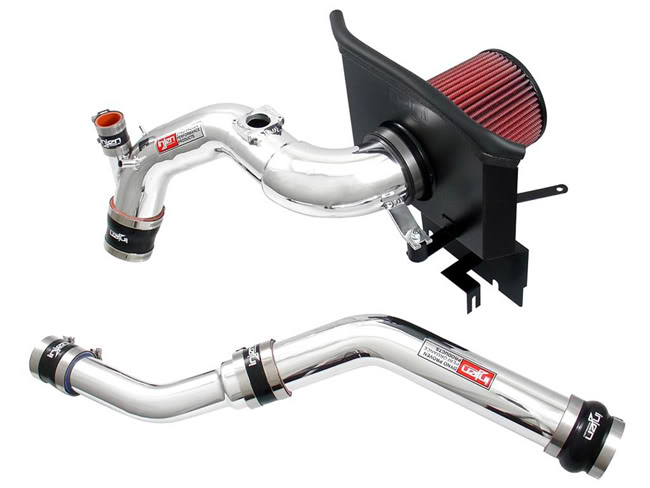
Agency Power
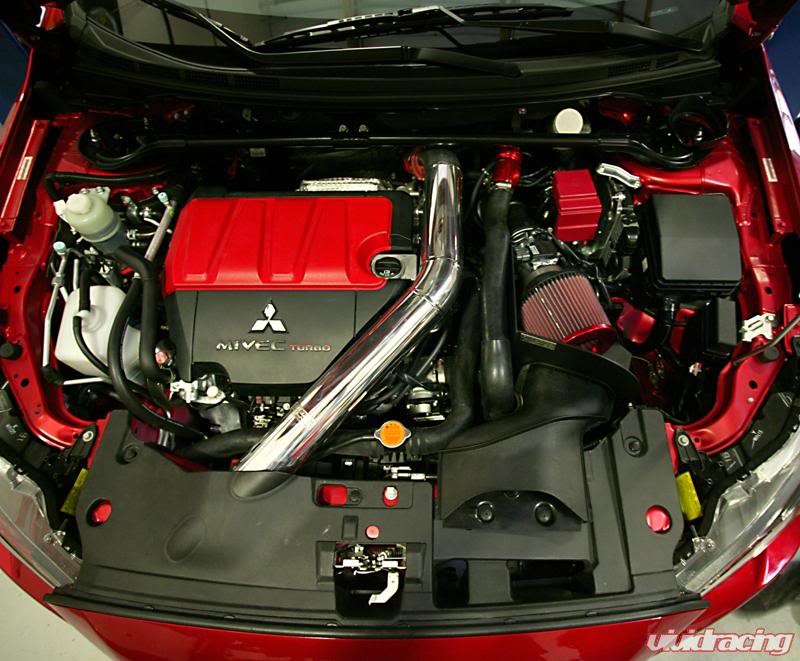
AMS
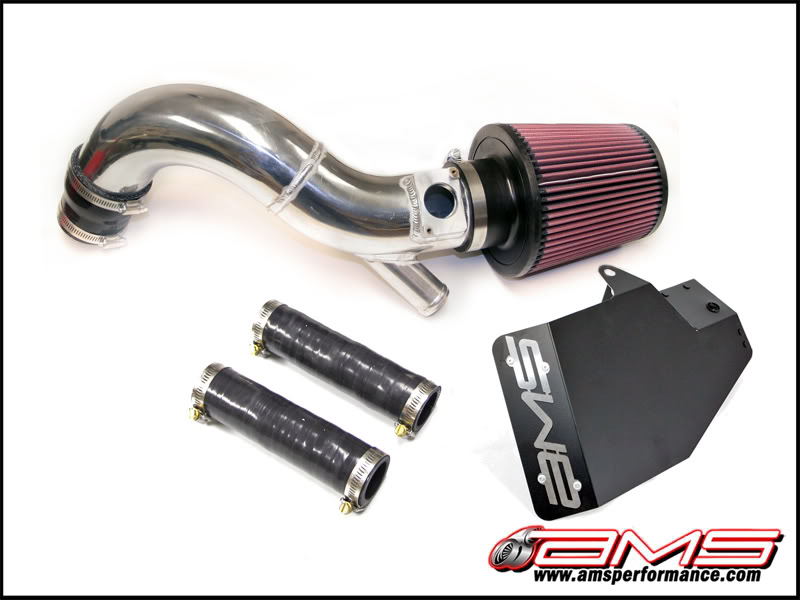
ETS
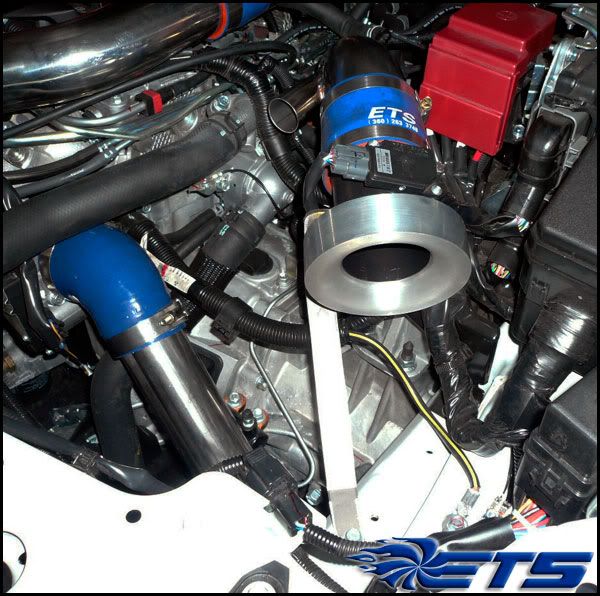
HKS
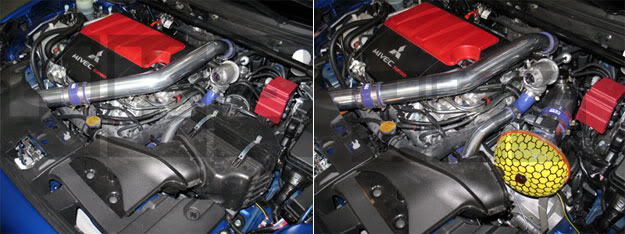
#4
Location of the MAF with respect to the filter element may have something to do with it. Most aftermarket cone filter intakes out there have the MAF located immediately behind the filter where the on the Injen it's further downstream. I'm interested what ideas others have about this.
#5
Evolved Member
iTrader: (3)
That is correct. The MAF location is critical for proper trim management. I have noticed that the location of the MAF on the Injen is different than the others you mention as well. You can add to the list the AEM intake. On two Evo Xs that I have logged the trims drifted >+10%.

#6
The placement of the MAF right after the filter (inline) is ideal. You want the incoming air flowing through the MAF meter as much as a "direct shot" as possible. Having a MAF located just after a bend, loop, twist, etc is not good, as the incoming air will favor one side of the sensor (due to the bend) and will not give you ideal readings thus allowing for a pita tuning or diagnosing session......
#7
The placement of the MAF right after the filter (inline) is ideal. You want the incoming air flowing through the MAF meter as much as a "direct shot" as possible. Having a MAF located just after a bend, loop, twist, etc is not good, as the incoming air will favor one side of the sensor (due to the bend) and will not give you ideal readings thus allowing for a pita tuning or diagnosing session......
Trending Topics
#8
ok, i looked at my logs before and after putting a aem cone filter at the end of the maf. the stock set up would run between +0.14% to +4.05% ltft. the cone filter is running at -2.20% to -4.20% ltft. while i have reversed correction, i am still within the desired 5% correction. am i correct in my intrerpretation?
#9
EvoM Community Team
iTrader: (15)
Does LTFT high really adjust on the evo X? On the IX mid is only active until 1580hz (generally about 120ish load I think, I would have to log).
You should see if there is a LTFT Current so you can get a better idea of when trims are working against your fueling.
Also, what is the load where the ECU switches to closed loop? In the IX it is 40-110 load (depending on RPM) and 0-66 TPS (also depending on RPM)
You should see if there is a LTFT Current so you can get a better idea of when trims are working against your fueling.
Also, what is the load where the ECU switches to closed loop? In the IX it is 40-110 load (depending on RPM) and 0-66 TPS (also depending on RPM)
Last edited by fostytou; Jul 31, 2009 at 09:39 PM.
#10
Thanks for the great writeup! So if your LTFT is slightly positive, say +3%, then the ECU is adding fuel - if I then reset the ECU, the car will actually runner leaner for a while because LTFT will be 0%? If I'm understanding this correctly, in a way, it's safer to have a slightly negative LTFT.
#13
Evolved Member
iTrader: (9)
Thanks for the great writeup! So if your LTFT is slightly positive, say +3%, then the ECU is adding fuel - if I then reset the ECU, the car will actually runner leaner for a while because LTFT will be 0%? If I'm understanding this correctly, in a way, it's safer to have a slightly negative LTFT.
If you reset the ECU and went open loop WOT then the car would likely run a little leaner until the LTFT's started to learn after the car was warmed up. Assuming the Short Term Fuel Trim (STFT) still has full range of adjustment it will just richen up a little more in closed loop to accomodate the leaner intake until it figures out the LTFT. If this is the case then it could potentially be dangerous if your car had a very lean intake and was at +12% LTFT.


 What would make the Injen stay closer than the others to that +/-5%?
What would make the Injen stay closer than the others to that +/-5%?